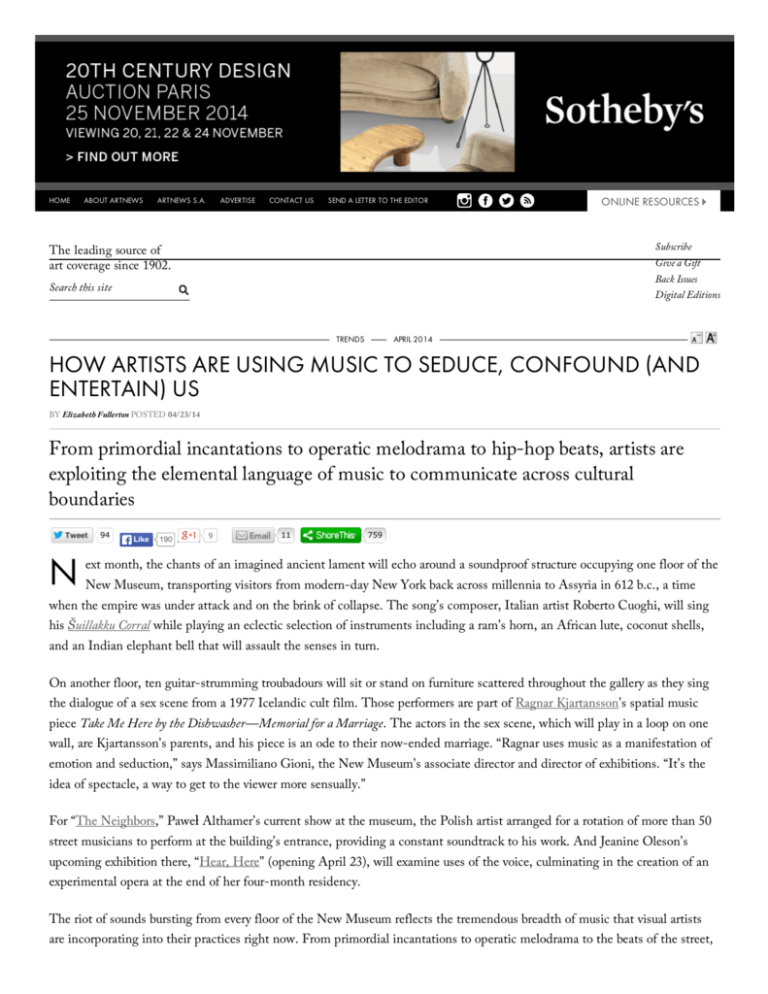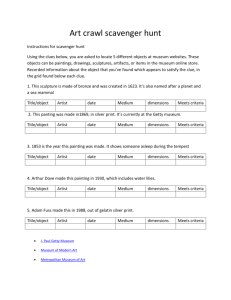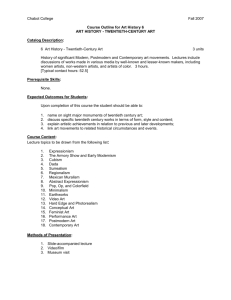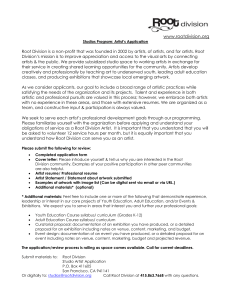
HOME
ABOUT ARTNEWS
ARTNEWS S.A.
ADVERTISE
CONTACT US
SEND A LETTER TO THE EDITOR
ONLINE RESOURCES
Subscribe
The leading source of
art coverage since 1902.
Give a Gift
Back Issues
Search this site
Digital Editions
TRENDS
APRIL 2014
HOW ARTISTS ARE USING MUSIC TO SEDUCE, CONFOUND (AND
ENTERTAIN) US
BY Elizabeth Fullerton POSTED 04/23/14
From primordial incantations to operatic melodrama to hip-hop beats, artists are
exploiting the elemental language of music to communicate across cultural
boundaries
N
94
Like
190
9
11
759
ext month, the chants of an imagined ancient lament will echo around a soundproof structure occupying one floor of the
New Museum, transporting visitors from modern-day New York back across millennia to Assyria in 612 b.c., a time
when the empire was under attack and on the brink of collapse. The song’s composer, Italian artist Roberto Cuoghi, will sing
his Šuillakku Corral while playing an eclectic selection of instruments including a ram’s horn, an African lute, coconut shells,
and an Indian elephant bell that will assault the senses in turn.
On another floor, ten guitar-strumming troubadours will sit or stand on furniture scattered throughout the gallery as they sing
the dialogue of a sex scene from a 1977 Icelandic cult film. Those performers are part of Ragnar Kjartansson’s spatial music
piece Take Me Here by the Dishwasher—Memorial for a Marriage. The actors in the sex scene, which will play in a loop on one
wall, are Kjartansson’s parents, and his piece is an ode to their now-ended marriage. “Ragnar uses music as a manifestation of
emotion and seduction,” says Massimiliano Gioni, the New Museum’s associate director and director of exhibitions. “It’s the
idea of spectacle, a way to get to the viewer more sensually.”
For “The Neighbors,” Paweł Althamer’s current show at the museum, the Polish artist arranged for a rotation of more than 50
street musicians to perform at the building’s entrance, providing a constant soundtrack to his work. And Jeanine Oleson’s
upcoming exhibition there, “Hear, Here” (opening April 23), will examine uses of the voice, culminating in the creation of an
experimental opera at the end of her four-month residency.
The riot of sounds bursting from every floor of the New Museum reflects the tremendous breadth of music that visual artists
are incorporating into their practices right now. From primordial incantations to operatic melodrama to the beats of the street,
they are exploiting the elemental language of music to communicate across
cultural boundaries. This sonic diversity also echoes the multifarious tastes
of Gioni, who curated last year’s acclaimed Venice Biennale show “The
Encyclopedic Palace.”
Starting in May, the contemporary vernacular of hip-hop will pulsate from
Camille Henrot’s kaleidoscopic video Grosse Fatigue (2013), which will be
a feature in her solo show at the New Museum. The French artist won the
Silver Lion at Venice last year for the work, which explores systems of
taxonomy and cultural production in an information overload reflective of
the digital age.
“Hip-hop is the new Esperanto,” says Gioni. “It’s more universal even
than rock and roll.”
Hip-hop and street culture figure prominently in “Art Into Music” at
BRIC House in downtown Brooklyn (through April 27). That show is
devoted to 12 artists—from Ward Shelley to Rashaad Newsome to the
duo Angel Nevarez and Valerie Tevere—whose multimedia work takes
inspiration from a wide range of music. “There’s a big group of artists who
Gio Andollo, one of the 50-plus street musicians providing a
soundtrack to Paweł Althamer’s current show at the New
Museum.
COURTESY NEW MUSEUM, NEW YORK
really want to make their work relevant, and so they’re using music as a
way to deal with the real world and address everyday issues,” says Elizabeth Ferrer, BRIC’s director of contemporary art. A
specially designed stage serves as a listening station for visitors to access the artists’ playlists.
The New Orleans–based performance artist Tameka Norris, who trained in fine art at UCLA and Yale after becoming
disillusioned with her efforts to become a superstar rapper, says her entire visual practice is rooted in the structure of rap music,
with its emphasis on sampling, appropriation, and remixing.
Norris uses rap to critique gender roles and racial politics in many of her music videos, which knowingly quote from art history
and popular culture. In Back to Black (2011), for instance, she plays three versions of Amy Winehouse simultaneously. “I’m this
woman of color co-opting a white British musician who’s co-opting a black musician. So it’s multiple levels of removal to get
back to the same thing or to get to a new thing,” she explains.
Tameka Norris as Amy Winehouse in Back to Black, 2011.
COURTESY THE ARTIST AND LOMBARD FREID GALLERY, NEW YORK
And Licker (2010) depicts Norris in a bikini and a fur coat gyrating around nude statues by Matisse and Rodin on the UCLA
campus. She alternates between the stereotypes of “sexy video vixen” and macho rapper as she sings, “I’m that black Cindy
Sherman and that little Kara Walker.”
The artist is now making a feature-length film for this fall’s Prospect.3 Biennial in New Orleans centered around her rapping
alter ego, Meka-Jean, as she reconnects with her hometown post–Hurricane Katrina. To kick off her current show “Too Good
for You (Introducing Meka-Jean)” at Lombard Freid Projects, Norris enacted an in-character performance of songs from the
film’s soundtrack, which she hopes will bring her full circle and launch her music career. “I’ve taken the most ass-backwards
route to becoming a pop celebrity,” she jokes.
There is, of course, an august tradition of visual artists making music and collaborating with avant-garde musicians. In New
York, the Guggenheim Museum’s survey of Italian Futurism and the Museum of Modern Art’s exhibition “There Will Never
Be Silence: Scoring John Cage’s 4’33”” demonstrate that curators are looking back at history to assess the impact of such
innovators as Futurist composer Luigi Russolo and modernist Cage on visual artists, which remains strong today.
Cage’s influence was prevalent in the recent exhibition “Music” at the Aldrich Contemporary Art Museum in Connecticut,
especially in a five-hour, three-part endurance performance conceived by Brooklyn-based artist Xaviera Simmons. The piece
consisted of a “system controller” holding up images based on chance, while Simmons splattered paint and other materials
onto a canvas. At the same time, a vocalist created a “soundscape” by building up and breaking down sounds and juxtaposing
vocal exercises with samples of rock, folk, jazz, and gospel.
The avant-garde allure of Cage’s 1952 “silent” composition 4’33” has been particularly irresistible to artists over the years. “I
think everyone has to have their 4’33” piece. It seems like a rite of passage,” says Jennie C. Jones, whose work often sets up
dialogues between avant-garde composers, jazz musicians, and visual artists to highlight their shared concern with the language
of abstraction. Jones’s own 4’33” piece, titled Slowly, In a Silent Way, Caged (2010), consists of the opening chords to Miles
Davis’s album In a Silent Way digitally slowed to run for the exact time of Cage’s iconic work. “Something that comes up again
and again for me is how Miles Davis and John Cage don’t get put in the same conversation but they are at the same historic
intersection,” Jones says.
In her solo show “Tone,” at the New York gallery Sikkema Jenkins & Co. (through April 5), Jones carries into that cultural
conversation the little-known but influential jazz arranger and trombonist Melba Liston, who toured with Dizzy Gillespie and
Count Basie in the 1940s and ’50s. Jones selected a snippet of Liston’s trombone playing and stretched it out to create an
atmospheric work. These haunting notes were devised to play in a loop in the gallery to accompany her minimalist paintings
made from industrial sound absorbers.
For multidisciplinary artist Sanford Biggers, however, music legends such as “Godfather of Soul” James Brown and saxophonist
John Coltrane have been at least as important to his artwork as Cage, whose followers have produced sound pieces that are
challenging to the ear. “There’s this attitude that if artists make music that is somehow appealing and too accessible, it
diminishes the validity of the practice, which I think is rubbish,” says Biggers, who regularly performs a blend of funk, punk,
sci-fi, and Asian influences in art spaces with his band, Moon Medicine. The artist, who has a site-specific performance this
month at Lincoln Center in Manhattan, interweaves layers of reference from African American history, Buddhism, and art
history using music, sculpture, video, and painting. He defines his work as “both/and—not either/or—music or art.”
Dinos Chapman—known for the penis-nosed child mannequins and sculptural tableaux of human savagery that he makes with
his younger brother, Jake—has also started making music, though his has
translated into commercial success. Chapman released his four-song EP
Luv2H8 last October, and the Britart provocateur has quickly become a
fixture on the electronic-music festival circuit. He has several gigs lined up
this year, including a slot at the storied English festival Glastonbury in the
summer. “It’s quite nice performing,” he says. “Normally, you do
something and you run away from it as fast as you possibly can. So actually
being pinned down on stage with a spotlight is quite different.”
After years of “fiddling around” on his computer in his basement,
Chapman was discovered by Sean Bidder, creative director of the
independent British record label The Vinyl Factory. Chapman’s debut
album, Luftbobler, a dance-y mixture of ambient and techno sounds, was
met with critical acclaim when it premiered last year, confounding
expectations of an audio version of the Chapman brothers’ brutal art. Jake
now wants to make a record with his rock band, Heimlich, whose music
he describes as “loud, noisy guitars with feedback.” A fraternal
collaboration may follow.
As well as managing
Sanford Biggers’s band, Moon Medicine, at the Rubin Museum
of Art in New York. Shown here is guest vocalist Imani Uzuri.
MICHAEL PALMA
Chapman’s musicindustry trajectory,
Bidder has a raft of
other artist projects.
These include a recording of the artist-musician Christian Marclay (of The
Clock fame) jamming in a café with Swedish saxophonist Mats
Gustafsson, a venture involving live performances by four musicians
responding to a moving robot sculpture by Conrad Shawcross, and an
electronic remix with Haroon Mirza. “It does genuinely feel like there is
quite a crossover and there is a lot of collaboration going on,” says Bidder.
“It’s quite a creative time.”
Digital technology has played an enormous role in democratizing the
music-making process, dispensing with the need for expensive
The cover of Dinos Chapman’s album Luftbobler.
COURTESY THE VINYL FACTORY, LONDON
instruments, mixing boards, tapes, and amplifiers since anyone who owns
a laptop can make music at home. Mirza regards the Internet as a catalyst for society’s eventual return to a primeval way of
being in which boundaries between disciplines and between the senses are broken down.
“There’s this tribalism that comes with the Internet,” the British installation artist and sound composer says. “One of the
undercurrents in my work is this idea that visual space and acoustic space could be perceived as one thing instead of two
separate things.” Mirza’s whirring, popping, fizzing sounds created on myriad electrical appliances have a primal rhythm that
transitions seamlessly from the gallery to the nightclub, and he has collaborated with various DJs to produce savvy remixes, as
well as deejaying himself.
Mexican artist Pedro Reyes taps into the emotive force and broad appeal of music as a vehicle for social change. As part of his
ongoing project “Disarm,” Reyes has reshaped hundreds of firearms into otherworldly instruments, which still resemble
weapons yet produce credible music, from metallic rock to hard-edge electronica.
“That physical transformation of a tool for killing into a tool for music triggers also a psychological transformation where our
violent instincts are sublimated,” says Reyes, who has staged numerous exhibitions and concerts to reach as wide an audience as
possible, most recently at the University of South Florida’s Contemporary Art Museum earlier this year. While Reyes says his
interest is not in obscure musical innovation, he and the other artists fusing music into their practice understand the visceral
power of sound and the immediacy of performance.
A concert of Pedro Reyes’s musical instruments made out of firearms.
WILL LYTCH
“There’s something very attractive about just being in a space with other human beings,” says David Toop, a sound curator,
musician, and author of several books on sound and music. “And sound is a strong statement—it still upsets and affects
people. I think that’s one of the reasons there’s such an interest in noise at the moment.”
For artist and musician Martin Creed, known for such pared-down artworks as a piano opening and slamming shut, the appeal
of performing with his band lies in getting an instant reaction from his audience—and the vulnerability that that entails.
“There’s something to be learned from actually being in your own work. It’s about trying to get real,” he says.
In conjunction with his retrospective at London’s Hayward Gallery, on view through April 27, Creed has released a new album
called Mind Trap with The Vinyl Factory/Telephone Records. He also composed two works for the show—an organ piece and
a ballet set to music played by his band—to be staged at nearby concert halls. “You cannot separate sound from the visual,”
Creed says. “I feel like if I don’t work on the sounds, it would be like pretending something wasn’t there. It would be fake.”
In line with the music/art zeitgeist, Bidder is looking to bring still more visual artists into his fold—he is eyeing Trinidad-
based painter Peter Doig and San Francisco graffiti artist Barry McGee—and aims to forge intriguing crossovers between the
pop and avant-garde realms. “We’re inspired by that whole New York downtown scene of juxtaposing things like Warhol next
to a street artist or Christian Marclay next to a Blondie and seeing what comes out of that,” says Bidder. “Maybe that’s an
interesting melting pot.”
Elizabeth Fullerton is a freelance writer based in London. She is working on a history of Britart to be published by Thames & Hudson.
A version of this story originally appeared in the April 2014 issue of ARTnews on page 82 under the title “Playing a Different
Tune.”
Copyright 2014, ARTnews LLC, 40 W 25th Street, 6th Floor, New York, N.Y. 10010. All rights reserved.
ARTICLE TAGS
ALDRICH CONTEMPORARY ART MUSEUM
BRIC HOUSE
DINOS CHAPMAN
ELIZABETH FULLERTON
FEATURED
GUGGENHEIM
HAROON MIRZA
HAYWARD GALLERY
JEANINE OLESON
JENNIE C. JONES
JOHN CAGE
LINCOLN CENTER
MARTIN CREED
MASSIMILIANO GIONI
MOON MEDICINE
MUSIC
NEW MUSEUM
PEDRO REYES
RAGNAR KJARTANSSON
ROBERTO CUOGHI
SANFORD BIGGERS
SEAN BIDDER
SIKKEMA JENKINS & CO.
TAMEKA NORRIS
THE VINYL FACTORY
XAVIERA SIMMONS
RECOMMENDED ARTICLES
KENNY SCHARF DELIVERS COSMIC
CAVERN MUSEUM THIS FALL
$36 M. FLAG SETS JASPER JOHNS
RECORD AT SOTHEBY'S $343.7 M.
CONTEMPORARY ART AUCTION
CHRISTIE'S CONTEMPORARY ART SALE
NETS $852.9 M., ALL-TIME AUCTION
RECORD
CONSUMER REPORTS: JIM DRAIN





